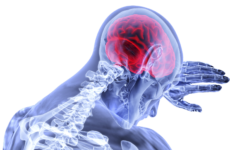
The intention of these monthly articles is to take complex events that happen within our mind and body and try to explain them in a simple manner. The purpose of this is so that you, the reader, can have a better understanding as to why you are either proactive or reactive to what is happening inside you and around you. For this issue, we will discuss how to better communicate with your emotions in order to have a happier life.
Understanding the way our bodies function on a chemical level is very important because it demonstrates clearly the essential bond between emotions and physical health. Therefore, if we can learn how to effectively communicate with our emotions, rather than being randomly guided by them, we can effectively be in control of our emotional health and physical health.
The unconscious mind is capable of initiating new emotional responses, which can trigger new chemicals in the brain and throughout the body. In other words, the entire endocrine system of hormone production can be controlled positively through the use of suggestion to the unconscious mind.
Positive emotion is a powerful tool that can reverse all negative effects of stress on the body. This means that the possibilities of positive transformation are very real, very easy and very effective, and not just in the area of eliminating stress but all kinds of other areas as well!
Mental Pictures
With mental pictures, it is very easy to change your feelings instantly. Your body gets used to or even addicted to whatever chemical is produced as a result of your thoughts. (i.e. If it’s drugs, then your body needs more drugs). For example, cigarettes are not addictive, but the illusion of what smoking does to your feelings is what makes smoking appear addictive. It’s an addiction to the feeling that smoking gives. Whether the addiction is good or bad, the craving is for the feeling that the addiction offers. The body’s cells want the fix of whatever they are used to getting.
Emotional Patterns
In order to create a change, the cell must be retrained to accept new chemicals. It can be retrained by creating a “feel good” response and thus creates a new pathway in the hypothalamus. This new pathway must be repeated over and over in order to effect a permanent change.
Simply put, there are only two kinds of feelings you can possibly experience: good feelings and bad feelings. Every kind of feeling you might have will be one or the other.
For example, take a moment in time when you feel happy and you say, “Wow I am really happy right now.” Once you recognize that you are happy, you let it go. You don’t even think about it anymore. The unconscious mind is trying to communicate to the conscious mind the action you were doing that made you feel good without you even realizing it.
With your conscious mind, you must ask ,“What was I doing that was causing me to feel happy?” The unconscious mind will reveal to the conscious what action to do in order to have those happy feelings again. Instead of flowing with the random pattern of emotional ups and downs, knowing what to do will give you the ability to create these “happy” feelings whenever you want to.
In the same way, feeling sad can cause you to focus on the opposite of what makes you happy. It might be that you focus on what is missing in your life. As you focus on what you don’t have, your feelings change from “happy” to “sad”. However, once you learn how to identify the “negative” thoughts that are making you “sad”, you can learn how to quickly change your thinking and focus on what makes you feel good, and your “sadness” will evaporate effortlessly and immediately.
Why “Positive Thinking” Doesn’t Always Work
Positive thinking is a good habit because it is a way of focusing on good things. It also creates a sense of thankfulness in the thought process, which contributes to a balanced mindset. But if you are trying to think positively without having identified the “sadness” or “tension” that is at the root of your thoughts, then your attempt at positive thinking is not effective.
Neuro-Pathways
To effectively rid yourself of any kind of “sadness,” you must fully understand it. Emotions and feelings create neuro-pathways in the mind. The neuro-pathways are like well-worn grooves of habitual thinking that have been established over a period of time and much repetition, like a well-worn path through a field of grass. If that neuro-pathway for sadness is deep and well worn, then it will always eat up the positive thoughts. The only way to eradicate old neuro-pathways is to not only establish new ones, but to carve them just as deeply into your psyche. This process takes a lot of time and work.
Creating Better Neuro-Pathways
There are always two ways of doing things: the hard way and the easy way. Using our conscious minds and our constructed, well-thought-out ideas to attempt to understand our own behaviours is usually the “hard way”. It takes a lot of time and effort and often leads to more questions than answers.
Our unconscious minds, however, operate far more quickly and effectively because when we use our unconscious minds, we can access a much greater intelligence than with our conscious minds. The unconscious mind is the birthplace of inspiration, creativity and enlightenment.
Likewise, there is a much faster way to solve the problem of “sadness” than remembering to work at creating new neuro-pathways by repeating them over and over again. The faster approach is simply to go right into the feeling by asking yourself these questions:
What am I feeling?
What is the purpose of this feeling?
What is the message this feeling is telling me?
If, for example, a close relative or even a family pet dies you experience “sadness”. The sad event is framed in a mental picture of the death. You think about the event of the death and also the lack of their presence in your life. The mental picture is created both about the present and the future. By changing your mental picture about the event, you can change the feelings associated with it. So instead of thinking of the “death,” you create a mental picture of all the moments of joy that were shared. As you picture those moments with a sense of gratitude for having experienced them, you are able to instantly lift your feelings into a more positive state. You know logically that death is an inevitable part of life, but you were blessed to share wonderful moments with another human being or animal. Your feelings are dictated by the choice of mental pictures you choose to focus on.
Everyday stress is not created by such dramatic events as “death”; however, these everyday events can play into a person’s general health. Most stress is created by an accumulation of small, irritating events that render you feeling powerless and unable to control them. However, now that you understand that you can actually control your thoughts, which in turn controls your emotions, you have the power to handle these stressful situations with more ease. By taking some time and practicing this new way or different way of thinking, you will find that it will actually help you to feel better about yourself and your surroundings, creating a happier life!




















